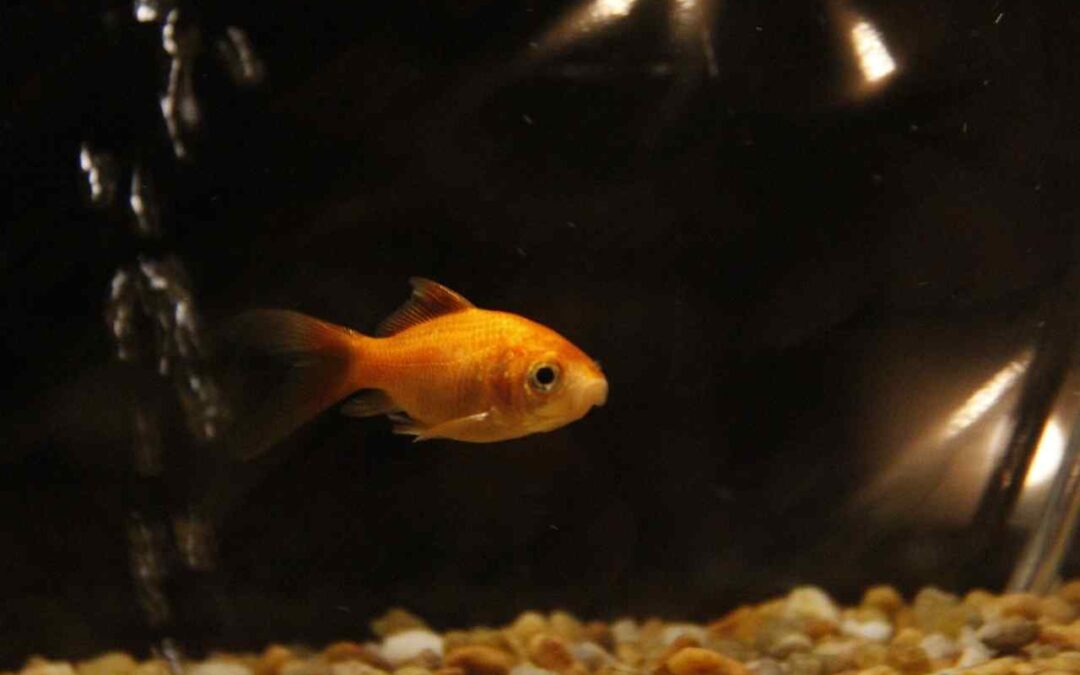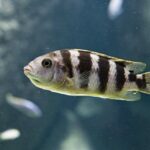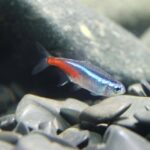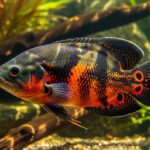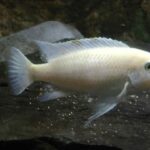Keeping goldfish might seem simple at first glance. After all, they’re one of the most iconic, beginner-friendly pets out there. But what many new aquarium owners don’t realize is that goldfish care goes beyond a small bowl and some flakes. These vibrant, curious swimmers need more room, cleaner water, and more attention than you might expect.
In this guide, we’ll take a deep dive into how to care for goldfish in an aquarium. From tank setup to water maintenance, feeding, and overall health tips, you’ll learn what it really takes to provide a healthy, enriching home for your aquatic companions.
Introduction to Goldfish in Aquariums
Goldfish are more than just carnival prizes. With proper care, these freshwater fish can live for decades and grow to surprising sizes—some over 10 inches long! Goldfish are curious, active, and incredibly rewarding to keep, but they do have very specific care needs that differ from tropical fish.
Despite their popularity, goldfish are often misunderstood. The classic image of a goldfish swimming alone in a small glass bowl is not only outdated—it’s harmful. Goldfish require space, clean water, and stimulation to thrive. Let’s explore how to give them the environment they truly need.
Understanding Goldfish Behavior and Needs
Goldfish are social, intelligent, and interactive fish. They recognize their owners, learn routines (like feeding times), and even beg for food. They enjoy swimming around, exploring their environment, and interacting with tankmates.
There are several types of goldfish, from common single-tailed varieties like Comets and Shubunkins to fancy goldfish with double tails, rounded bodies, and unique features like bubble eyes or lion heads. While their basic care is similar, fancy goldfish are generally less hardy and need gentler environments due to their body structure.
Key behavioral traits:
- Active swimmers
- Social, especially with other goldfish
- Messy eaters and heavy waste producers
- Prone to scavenging and foraging behavior
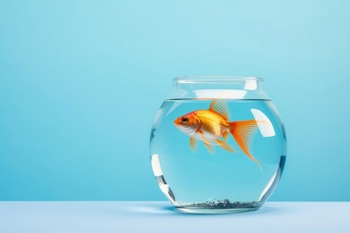
Choosing the Right Tank Size
If there’s one golden rule in goldfish keeping, it’s this: bigger is always better when it comes to tank size.
✅ Minimum Tank Size:
- Juvenile goldfish need at least 20 gallons for one fish.
- Adult goldfish require 20 gallons each, with 10 extra gallons per additional fish.
✅ Why the Large Tank?
Goldfish produce a large amount of waste. A small tank not only becomes dirty fast, but also limits swimming space and stresses the fish.
A 10-gallon tank, often sold as a “starter kit,” is simply not enough—even for one small goldfish.
Ideal Tank Setup for Goldfish
🟦 Tank Shape:
Opt for wide, rectangular tanks. Tall or narrow tanks reduce surface area for oxygen exchange, which goldfish need.
🛠 Filtration:
Use a filter rated for a tank size at least one step above yours. Goldfish are dirty, and a powerful filter helps maintain water quality.
🌿 Decorations:
- Smooth, non-sharp decorations to avoid fin tears
- Live or silk plants (goldfish may eat real ones!)
- Avoid tiny gravel—goldfish may ingest it accidentally
🧢 Lid:
Goldfish can jump, so a secure lid is essential to prevent tragic escapes.
Essential Equipment
Here’s a rundown of the basics every goldfish tank should have:
- Tank (minimum 20 gallons)
- High-quality filter
- Air pump or bubbler (optional but helpful for oxygen)
- Heater (depends on your climate; not always needed)
- Thermometer
- Water conditioner (dechlorinator)
- Test kits (for ammonia, nitrites, nitrates, and pH)
Maintaining Water Quality
Goldfish are heavy waste producers. Without proper water maintenance, harmful toxins like ammonia and nitrites build up, leading to illness or death.
🌀 Regular Maintenance:
- Weekly 20–30% water changes
- Gravel vacuuming during water changes
- Filter media rinsed in old tank water every few weeks (not tap water!)
⚠️ Always Use Dechlorinator:
Tap water contains chlorine and chloramine, which are toxic to fish. Use a water conditioner every time you add new water to the tank.
Water Parameters: Temperature and pH
Goldfish are cold-water fish, but they still need stable temperatures and balanced water chemistry.
🌡 Temperature:
- Optimal: 65–72°F (18–22°C)
- Avoid rapid fluctuations
- Fancy goldfish may prefer slightly warmer water (~70°F)
📊 pH:
- Ideal pH: 5–7.5
- Stable pH is more important than perfect numbers
🧪 Test Often:
Regularly test your water with reliable aquarium test kits, especially after adding new fish or adjusting the setup.
Feeding Your Goldfish
Goldfish love to eat—but that doesn’t mean they should eat everything!
🍽 Feeding Tips:
- Feed once or twice a day
- Use floating or sinking pellets formulated for goldfish
- Give only what they can finish in 1–2 minutes
- Supplement with blanched veggies (peas, spinach, zucchini)
⚠️ Avoid Overfeeding:
Excess food fouls the water quickly and can lead to digestive issues like swim bladder problems.
Substrate, Plants, and Decorations
🪨 Substrate:
- Use smooth gravel or large pebbles that goldfish won’t swallow
- Some keepers opt for bare-bottom tanks for easier cleaning
🌿 Plants:
- Goldfish may nibble live plants, but many love to forage through them
- Good plant choices: Java fern, hornwort, anubias (tougher plants)
- Avoid delicate plants like cabomba
🏺 Decorations:
- Avoid sharp edges
- Avoid hollow objects where fish can get stuck
- Offer caves or arches for enrichment, especially in larger tanks
Common Mistakes to Avoid
Here are frequent goldfish care missteps—and how to avoid them:
| Mistake | Better Practice |
| Keeping goldfish in a bowl | Use a minimum 20-gallon filtered tank |
| No filter or small filters | Use oversized filtration systems |
| Overfeeding | Feed small portions 1–2x daily |
| Infrequent water changes | Change 20–30% weekly |
| Mixing tropical fish with goldfish | Keep goldfish with cool-water species |
| Using untreated tap water | Always dechlorinate new water |
Signs of Stress or Illness
Paying attention to your goldfish’s behavior and appearance can help catch issues early.
🐟 Common Signs:
- Clamped fins
- Lethargy or unusual swimming
- Gasping at surface
- Loss of appetite
- White spots or visible lesions
- Rapid gill movement
Tip: Quarantine new fish before adding them to your main tank to prevent disease outbreaks.
Goldfish Tankmates: Who Can Live Together?
Goldfish can live with other peaceful, cold-water fish—but not just any species.
✅ Compatible Tankmates:
- Other goldfish (similar size)
- White cloud mountain minnows
- Weather loaches
- Rosy barbs (with caution)
❌ Avoid:
- Tropical fish (need warmer water)
- Fin-nippers like tetras or barbs
- Bettas or aggressive species
Always research specific compatibility and watch interactions closely when introducing new tankmates.
Seasonal and Long-Term Care
If you keep goldfish indoors, seasonal changes matter less. But if they’re outside (in ponds), here’s what to keep in mind:
🌡 Winter:
- Outdoor ponds must be deep enough to prevent freezing solid
- Goldfish become less active in colder months; feeding slows
☀️ Summer:
- Prevent overheating in tanks exposed to sunlight
- Use fans or partial water changes to keep temperatures safe
Goldfish can live 10–20 years (sometimes more) with proper care. Some pond goldfish have lived over 30 years!
Goldfish Fun Facts
- Goldfish were domesticated over 1,000 years ago in China.
- They can recognize human faces and routines.
- Goldfish don’t have stomachs—hence the need for frequent, small feedings.
- Their memory span is much longer than the myth of 3 seconds—they can remember things for months.
- A goldfish’s growth is limited by its environment—give them room, and they can grow large and beautiful.
Goldfish Aquarium Care Checklist ✅
Here’s a handy checklist you can follow to make sure you’re giving your goldfish the best care possible:
🐟 Goldfish Aquarium Setup
- Minimum 20-gallon tank for one goldfish
- 10 extra gallons per additional goldfish
- Wide tank shape (not tall and narrow)
- Secure lid to prevent jumping
- Smooth decorations and safe substrate
💧 Water Quality
- High-capacity filter installed
- Weekly 20–30% water changes
- Water conditioner/dechlorinator used
- Monitor ammonia, nitrite, nitrate, and pH
- Temperature maintained (65–72°F)
- pH stable between 6.5–7.5
🍽 Feeding
- Feed once or twice daily
- Use goldfish-specific pellets or flakes
- No overfeeding (remove uneaten food)
- Supplement with veggies (peas, zucchini)
👀 Observation
- Watch for unusual swimming or behavior
- Inspect fins, body, and eyes weekly
- Quarantine new fish before adding
- Research compatible tankmates
Understanding Goldfish Growth: Size vs. Space
One of the biggest misconceptions about goldfish is that they “grow to the size of their tank.”
While that’s partly true, it’s more about stunted growth due to poor conditions—and that’s not a good thing.
Goldfish have the genetic potential to grow over 10 inches long.
If they’re kept in a tank that’s too small, their organs keep growing even if their bodies don’t, which leads to serious internal issues, shortened lifespans, and a lower quality of life.
🐠 Real-Life Example:
Ever seen one of those huge, bright orange goldfish in a pond that looks more like a koi than a typical pet store goldie? That’s what happens when you give them space, clean water, and time. They don’t just survive—they thrive.
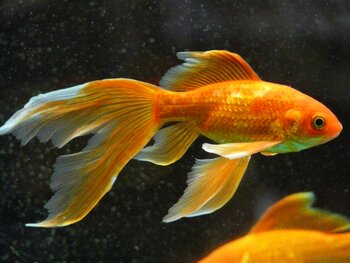
How to Cycle a Goldfish Tank
Before you ever put a goldfish in its new tank, it’s crucial to cycle the tank first. This isn’t some advanced aquarist step—it’s foundational fishkeeping.
🌀 What is Cycling?
Cycling establishes beneficial bacteria in the tank that help break down waste (ammonia) into less harmful compounds (nitrites, then nitrates). Without this process, your tank will become toxic fast.
🔁 How to Cycle:
- Set up the tank with your filter and heater (if needed).
- Add a source of ammonia (either fish food or bottled ammonia).
- Test the water daily.
- Wait until ammonia and nitrites spike and drop to zero—while nitrates begin to appear.
- The cycle usually takes 4–6 weeks.
Once your tank is cycled, then it’s safe for fish.
Fancy vs. Common Goldfish: Care Differences
Not all goldfish are created equal in terms of care.
🧬 Common Goldfish (like Comets and Shubunkins):
- Sleek, fast swimmers
- Grow quite large—better suited for ponds
- Need more space due to activity level
- Hardy in colder water
🎀 Fancy Goldfish (like Orandas, Fantails, Ranchus):
- Slower swimmers with more delicate fins and bodies
- Prone to swim bladder issues due to body shape
- Better in indoor aquariums with minimal current
- Prefer slightly warmer water (~70°F)
Tip: Avoid mixing fancy and common goldfish—they don’t swim at the same pace and can outcompete each other for food.
Enrichment: Keep Your Goldfish Mentally Stimulated
Yes, goldfish can get bored. An enriching tank environment promotes healthier, more natural behavior.
🧠 Simple Ways to Add Enrichment:
- Rearrange decorations occasionally
- Add new plants or floating ornaments
- Place a mirror (briefly) outside the tank
- Create gentle current zones using bubblers or filters
- Hand-feed or use feeding rings to encourage interaction
Enrichment reduces stress, encourages exploration, and keeps your goldfish mentally and physically active.
Why Goldfish Aren’t Good for Bowls (Ever)
There’s a reason the “goldfish in a bowl” stereotype is slowly disappearing—it’s not just outdated; it’s harmful.
Goldfish bowls:
- Lack filtration
- Have little surface area for oxygen exchange
- Accumulate toxins rapidly
- Are too small to maintain stable temperatures
- Don’t allow enough space for natural behaviors
Even if you change the water daily, it’s nearly impossible to maintain safe conditions in a bowl. It’s like keeping a puppy in a closet—technically possible, but incredibly unhealthy.
If you love your goldfish, give them the room they deserve.
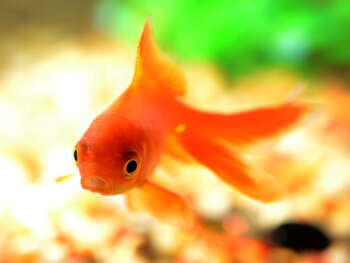
Goldfish Ponds: Outdoor Options
Goldfish aren’t limited to indoor tanks—they thrive in outdoor ponds too!
🏞 Benefits of Ponds:
- More space for swimming and growth
- Natural light cycles
- Seasonal behavior (they’ll go dormant in cold winters)
- Beautiful additions to gardens or patios
❄ Wintering in Ponds:
- Ponds should be at least 2 feet deep to prevent freezing
- Use a de-icer or air stone to keep a hole open in the ice for gas exchange
- Stop feeding once the temperature drops below 50°F
Outdoor goldfish often live longer and grow bigger thanks to natural conditions and larger volumes of water.
Breeding Goldfish: A Brief Overview
If you’re caring for multiple goldfish in a large tank or pond, you may witness spawning behavior, especially in spring.
💞 How to Tell:
- Males chase females and nudge them against surfaces
- Females become rounder with visible eggs
- Eggs are scattered on plants or surfaces
What Happens Next?
Goldfish can lay hundreds of eggs, but they also eat them. If you want to raise fry:
- Remove adults after spawning
- Keep eggs well-oxygenated
- Feed fry with infusoria or baby brine shrimp once hatched
Most hobbyists don’t breed goldfish intentionally, but if it happens, it’s a fascinating learning experience.
Troubleshooting Common Goldfish Problems
Even with great care, issues can arise. Here’s how to spot and fix common goldfish problems:
💩 Ammonia Spikes
Cause: Overfeeding, uncycled tank, overcrowding
Fix: Do a large water change (40–50%), reduce feeding, check filter media, test water
🫧 Swim Bladder Disorder
Cause: Overfeeding, poor-quality food, constipation
Fix: Fast the fish for 1–2 days, then feed peeled boiled peas
🌡 Temperature Shock
Cause: Sudden water temperature changes
Fix: Always match temperatures during water changes within 1–2°F
👁 Cloudy Eyes or White Fuzz
Cause: Poor water quality or fungal/bacterial infection
Fix: Improve water conditions, possibly use a medication (under guidance)
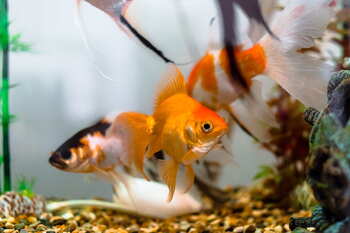
Realistic Costs of Goldfish Keeping
Goldfish are often seen as low-cost pets, but a proper setup requires some investment.
💸 Startup Costs:
| Item | Average Cost |
| 20–30 gallon tank | $60–$120 |
| Filter | $30–$70 |
| Heater (optional) | $20–$40 |
| Substrate & decor | $30–$60 |
| Water test kit | $15–$30 |
| Water conditioner | $10–$15 |
| Food | $5–$15 |
💵 Ongoing Monthly Costs:
- Food: $5–$10
- Water conditioner: $2–$5
- Replacement filter media: $5–$10
Compared to other pets, goldfish are relatively affordable—but keeping them healthy does take a budget and effort.
Myths About Goldfish: Busted
There are so many goldfish myths out there. Let’s debunk a few:
❌ Myth 1: “Goldfish only live for a few years.”
➡ Truth: With proper care, they can live 10–20 years or more.
❌ Myth 2: “Goldfish have 3-second memories.”
➡ Truth: Goldfish have excellent long-term memory and can be trained.
❌ Myth 3: “You can keep goldfish in a bowl.”
➡ Truth: Bowls are harmful. Goldfish need large, filtered tanks to thrive.
❌ Myth 4: “They don’t need a filter if you change the water.”
➡ Truth: Filters are essential for biological filtration—not just clean water, but safe water.
Tips for Traveling Goldfish Owners
Going on vacation? Here’s how to make sure your goldfish stay safe:
🧳 Before You Leave:
- Do a water change 1–2 days before
- Feed a small meal before leaving
- Use an automatic feeder (tested in advance!)
🛑 Avoid:
- “Vacation feeder blocks” – they often pollute the water
- Asking untrained friends to feed unless they follow specific instructions
For trips under a week, your goldfish can safely fast, especially in cool water.
Teaching Kids Responsible Goldfish Care
Goldfish are often given to kids as “starter pets,” but they’re a great way to teach responsibility when approached the right way.
🧒 Let Kids Help With:
- Feeding (under supervision)
- Water testing (use it as a science experiment!)
- Choosing tank decorations
- Observing behavior and reporting changes
Caring for goldfish together builds life skills, compassion, and respect for living creatures.
Upgrading Your Setup: When and How
Eventually, you may outgrow your goldfish tank—or your goldfish may outgrow it! Here’s when to consider an upgrade:
⬆️ Signs It’s Time:
- Your goldfish are full-grown and have limited swimming space
- You want to add another fish
- Your current tank requires frequent deep cleaning
- You’re dealing with persistent water issues
Tips for a Smooth Transition:
- Cycle the new tank before moving the fish
- Transfer filter media or decorations to seed good bacteria
- Acclimate fish slowly to the new water
Wrapping It All Up
Goldfish are often underestimated—but with the right care, they transform into some of the most delightful pets you can own. Watching them swim gracefully through a well-maintained tank brings peace, joy, and even a bit of personality into your home.
From tank setup to feeding, health monitoring, and long-term care, every detail counts. But the good news is: it’s all doable. You don’t need to be an expert to provide a great life for your goldfish—you just need the right information and the willingness to commit to their care.
So whether you’re planning your first goldfish tank or upgrading your long-time setup, you’re already on the path to becoming a great fishkeeper.
Here’s to sparkling tanks and happy goldfish!

